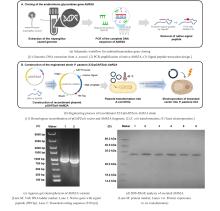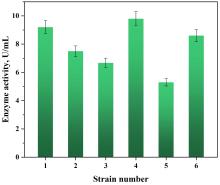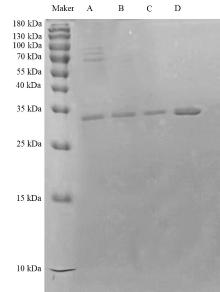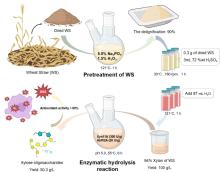|
||||||||||||||||||||||||||||||||||||||||||||
|
Biosynthesis of xylo-oligosaccharides from wheat straw xylan via the synergistic hydrolysis by xylanase Xyn11A and arabinofuranosidase Abf62A
Synthetic Biology Journal
DOI: 10.12211/2096-8280.2025-037
Table 2
Sugar content and proportion in xylan hydrolysates of different WS.
Extracts from the Article
The synergistic enzymatic hydrolysis of wheat straw xylan by Xyn11A and Abf62A yielded substantial XOS production, with detailed compositional analysis presented in Table 2. The reaction conditions were as follows: The Xyn11A of 200 U/g substrate and Abf62A of 20 U/g substrate were supplemented to the solution containing 100 g/L of xylan and reacted at 60 °C and pH 5.0 for 6 h. Under the synergistic enzymatic hydrolysis under optimum conditions, the total sugar content from the hydrolysis of UTX was 23.45 g/L. Compared with the results of enzymatic hydrolysis without Abf62A, the sugar concentration had no apparent increase. Because the content of arabinose in UTX was not high, Abf62A had little influence on assisting Xyn11A. In addition, due to the direct extraction of xylan without pretreatment, other components in UTX, mainly cellulose and lignin, will produce irreversible adsorption with the enzyme in the process of enzymatic hydrolysis, which greatly reduced the activity of the enzyme. In contrast, the results of enzymatic hydrolysis of PTX with Xyn11A and Abf62A were entirely different. All sugar contents were greatly increased. The content of XOSs reached 50.3 g/L, including xylobiose (31.71 g/L), xylotriose (15.92 g/L), xylotetraose (1.65 g/L) and xylopentaose (1.04 g/L). Compared with the results of enzymatic hydrolysis without Abf62A, the xylobiose content increased obviously, reaching 10.86 g/L. The above results showcased that WS samples before and after pretreatment had a great influence on the subsequent enzymatic saccharification of xylan. The content of XOSs produced by PTX enzymatic hydrolysis was much higher than that of UTX, in which the proportion of DP2-5 XOSs was more than 92%, which was the main factor affecting the probiotic effect of XOSs. The color value of PT-XOS was also much lower than that of UT-XOS, which greatly reduced the purification steps of XOSs, saved operation time and performance cost. The synergy between Xyn11A and Abf62A stems from complementary roles: Abf62A removes arabinose substitutions at xylan’s O-2/O-3 positions, reducing steric hindrance and enabling Xyn11A to efficiently cleave β-1,4-glycosidic bonds. Lignin removal during pretreatment further minimizes non-productive enzyme binding. This mechanism aligns with prior studies demonstrating that arabinose debranching enhances xylan accessibility [36].
Other Images/Table from this Article
|
||||||||||||||||||||||||||||||||||||||||||||






